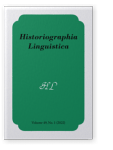Vol. 49:1 (2022) ► pp.1–38
Lapsus et apposition de rectification de l’arabe
Contribution à une histoire comparée des traditions grammaticales
Si, pour nos traditions grammaticales européennes, la reconnaissance des appositions comme objet grammatical et non plus seulement comme éléments ressortissants à la rhétorique ne se fait que tardivement et non sans allers-retours, en gros vers le xvi e siècle, celles-ci sont intégrées à la grammaire de l’arabe dès le début de son histoire au ii e/viii e siècle. La prime tradition grammaticale arabe reconnaît même, de manière implicite mais suffisamment claire, l’opposition à faire entre apposition liée et apposition détachée, ce que nos traditions grammaticales attendrons encore longtemps. Un autre trait de la singularité de la tradition grammaticale arabe sur cette question de la reconnaissance grammaticale des appositions, fait l’objet de cet article : elle est semble-t-il la première mais encore la seule à intégrer à son matériau grammatical l’erreur commise par le locuteur, qu’il s’agisse d’une faute d’inattention ou d’un oubli momentané, c’est-à-dire ce qui est nommé depuis le xx e siècle et ses préoccupations propres lapsus (linguae, memoriae). Et si elle en traite grammaticalement, c’est parce qu’elle reconnaît les corrections de ces erreurs comme des types d’apposition, des permutations, ce que ne fait encore que très imparfaitement la linguistique générale contemporaine et pas du tout les grammaires des langues européennes. Cet article met en avant la contribution que la grammaire de l’arabe peut apporter à la grammaire générale en lien avec grammatisation des appositions.
Article outline
- 1.La très singulière grammatisation arabe des appositions
- 2.Le lapsus et sa correction
- 2.1Définitions et descriptions du lapsus dans l’aire occidentale
- 2.2La tradition arabe
- 3.Le permutatif de rectification
- 4.La grammaire arabe médiévale classique
- 5.Les autres traditions grammaticales: Mutisme et/ou surdité
- 5.1Le sémitique oriental: L’akkadien
- 5.2Le sémitique occidental: Syriaque, araméen, hébreu
- 5.3L’indo-européen oriental
- 5.4L’indo-européen occidental
- 6.Rhétorique
- 7.Linguistique et grammaire contemporaines
- 8.Conclusion
- Remerciements
- Noter
-
Références
Article language: French
